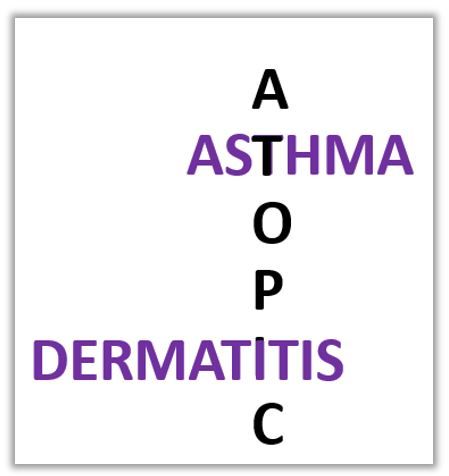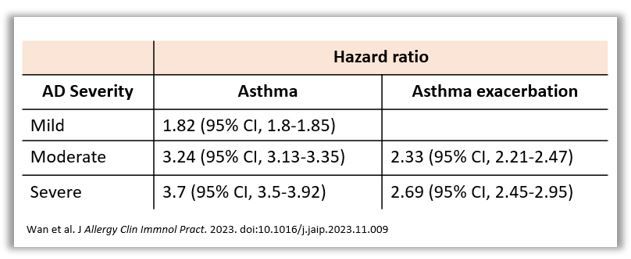- Clinical Technology
- Adult Immunization
- Hepatology
- Pediatric Immunization
- Screening
- Psychiatry
- Allergy
- Women's Health
- Cardiology
- Pediatrics
- Dermatology
- Endocrinology
- Pain Management
- Gastroenterology
- Infectious Disease
- Obesity Medicine
- Rheumatology
- Nephrology
- Neurology
- Pulmonology
Risk for Incident Asthma and Exacerbations Increases with Atopic Dermatitis in Dose-Dependent Fashion: Study
The risk of asthma and poor outcomes was even greater among children with both conditions than among adults in this first study to compare the 2 populations.
Both adults and children with atopic dermatitis (AD) were found at increased risk for asthma, asthma exacerbations, and asthma-related hospitalizations, according to new research, with children with AD having nearly double the risk (96%) for developing asthma as their peers without the disease.

The findings, from a longitudinal cohort study of electronic health records in the United Kingdom, were published in The Journal of Allergy and Clinical Immunology: In Practice.
The risk for developing asthma among adults was found 38% greater for those with AD than for matched study participants without AD, according to Joy Wan, MD, MSCE, assistant professor of dermatology, department of dermatology, Johns Hopkins University School of Medicine, and colleagues.
The risk for all 3 outcomes increased with AD severity in a dose-dependent fashion in both the adult and pediatric populations, the investigators wrote.
Approximately 40% of individuals with AD go on to develop asthma but the majority of studies have been conducted in birth cohorts of children under the ages of 3 to 11 years, according to the study. Much less is known, authors added, about asthma in older youth and adults. Moreover, research conducted on the association between AD in early life and asthma in adult life have been primarily survey based and at single points in time.
To develop their study population, Wan and colleagues tapped records for both children (<18 years old) and adults (≥18 years) using electronic health records data between 1994 and 2015 from The Health Improvement Network, a system including more than 600 general practices in the UK.
Children with AD
The researchers identified 409 431 children with AD: 93.2% had AD classified as mild (median age, 4 years), 5.5% had moderate AD (median age 9 years) and 1.3% had severe AD (median age, 5 years). They also identified 1 809 029 children who did not have AD (median age, 4 years).
Among the pediatric cohort that did not have AD, investigators identified 169 679 (9.4%) children with asthma and in the cohort of children who did have AD, they reported 57 098 (13.9%) children had asthma.
Overall, the researchers said that children with AD had greater rates of asthma, asthma exacerbations and asthma hospitalizations than children who did not have it and that these rates increased with the severity of the AD.
When they compared children with AD to those without, the children with the condition were at approximately 2-fold greater risk for new-onset asthma vs those without (hazard ratio, 1.96; 95% CI, 1.93-1.98). Specific hazard ratios for developing asthma by level of AD severity are below.

Wan and colleagues also found that among all children with asthma who also had AD, the risk of an asthma exacerbation was significantly greater (63%) than among those who did not have AD (HR, 1.63; 95% CI, 1.59-1.68). The hazard ratio for asthma exacerbations also were significantly higher and increased with severity of AD, reaching 2.33 (95% CI, 2.21-2.47) for moderate AD and 2.69 (95% CI, 2.45-2.95) for severe AD.
The children with both asthma and AD were similarly more likely—by 64%—to be hospitalized for their asthma compared with children who had asthma but did not have AD. The researchers reported a very substantial increase in risk of asthma-related hospitalization among children with moderate AD and severe AD, at 163% and 195%, respectively. Excess disease exacerbations numbered 3862 and excess hospitalizations 1381 in children with both asthma and AD.
Adults with AD
Turning their attention to adults, Wan et al analyzed records from 625 083 adults with AD (median age range among severity groups, 45-50 years); 65.7% had mild AD, 31.4% had moderate AD, and 2.9% were classified as having severe AD. This group was matched with 2 678 888 adults who did not have AD (median age, 47 years).
Adults with asthma without AD: 346 024 (12.9% cohort without AD)
Adults with asthma with AD: 127 459 (20.4% of the cohort with AD)
Researchers reported trends among adults similar to those observed among children with all outcomes more pronounced in the subgroups with AD and rates increasing for all 3 outcomes with greater severity of AD.
The risk for incident asthma among adults with AD was 38% greater than for adults without AD (HR, 1.38; 95% CI, 1.36-1.4). By level of asthma severity, risk was 27% greater with mild AD, 52% with moderate AD and 58% with severe AD.
While not as pronounced as the risk for exacerbation reported for children with asthma and AD, the risk for asthma exacerbation in the elder cohort with both conditions was 21% greater than for adults who only had asthma. Hazard ratios for exacerbation included 1.13 (95% CI, 1.1-1.17) for mild AD, 1.3 (95% CI, 1.26-1.34) for moderate AD and 1.37 (95% CI, 1.27-1.48) for severe AD. Adults with AD also had 1,843 excess exacerbations and 891 excess hospitalizations.
The "atopic march" has been proposed to explain the induction of asthma by AD, the researchers wrote. They note that while the risks for new-onset asthma, exacerbations, and hospitalizations increased with the severity of AD in both pediatric and adult populations, the risks were more pronounced in the younger population, suggesting that atopic march may be less common among older individuals. They called for additional studies to explore the relationships between different AD and asthma endotypes and how they may vary by age.
"As novel immunomodulatory medications for AD continue to emerge, their effects on asthma development and severity will be f great interest, with the hope that future therapies may curtail progression along the atopic march," they concluded.
Source: Wan JW, Wang S, Shin DB, et al. Incident asthma, asthma exacerbations, and asthma-related hospitalization in patients with atopic dermatitis. J Allergy Clin Immunol Pract. Published online November 14, 2023. doi:10.1016/j.jaip.2023.11.009
Kymera's Oral STAT6 Degrader KT-621 Shows Biologic-Like Activity in Early Atopic Dermatitis Trial
December 8th 2025KT-621 achieved deep STAT6 degradation and strong 4-week EASI and itch reductions, offering a potential new oral option for moderate–severe AD and other Th2 inflammation-driven disease.
